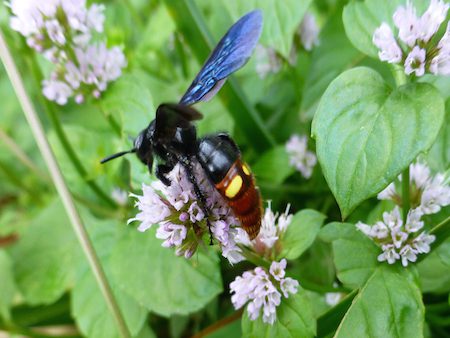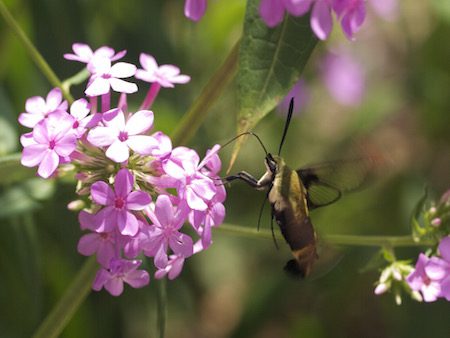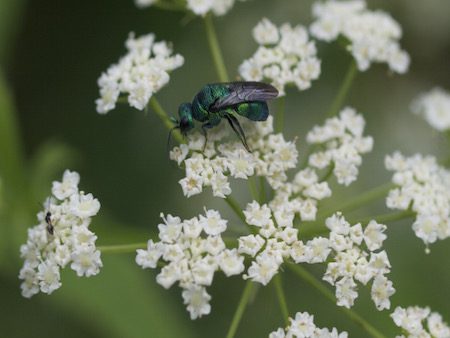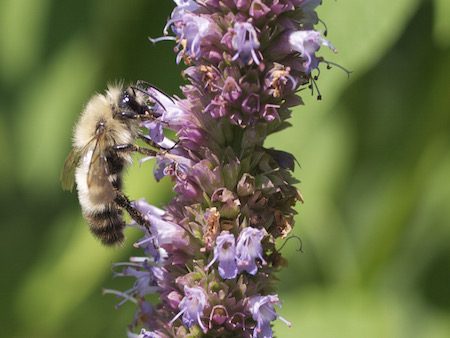Many gardeners are intent on keeping bugs out of their garden, but I’m happy to invite them in for a visit, and then encourage them to make themselves right at home inside my veggie garden! Of course I’m referring to beneficial insects; the ones that pollinate flowers and feast on the bad bugs for dinner.
Rather than purchase Ladybugs, Mantis cases, or other beneficials, I take a different approach by raising flowering plants that will naturally attract pollinators and provide them with food and shelter. I also resist applying poisonous sprays to the landscape because they can wipe out beneficial insects right alongside of the destructive ones.
Reducing Pesticide Sprays to Encourage the Beneficials to Stay
 This is the third season since I began making a concerted effort to add more native plants to my landscape. It’s been longer than that since I decided to stop spraying any type of pesticide in the garden; including the organic types. The problem with spraying any pesticide is that if it has an impact on the harmful insects it’s likely to hurt the populations of beneficial insects as well.
This is the third season since I began making a concerted effort to add more native plants to my landscape. It’s been longer than that since I decided to stop spraying any type of pesticide in the garden; including the organic types. The problem with spraying any pesticide is that if it has an impact on the harmful insects it’s likely to hurt the populations of beneficial insects as well.
If you do need to spray, target only the insects that are doing significant damage and threatening an entire crop or harvest. And spot spray so that the organic pesticide is only being applied to the specific crop that is in jeopardy. As crazy as it may sound, I actually want there to be some aphids, cabbage worms, and other destructive insects around just to help make the predators fat and happy, and to give them a reason to multiply!
Plants and Insects were Created for Each Other!
I’m amazed by the insects that I see on a daily basis and plan to put in additional beds devoted to native plants to attract even more beneficial insects. Some of the popular plants with my pollinators include; Bee Balm, Butterfly Weed, Sunflowers, Milkweed, Joe Pye Weed, Coneflower, Phlox, Goldenrod, Mint, Phacelia, Boneset, and Asters.
The tiny beneficial insects are especially attracted to the clusters of compound flowers produced by plants such as Yarrow, Dill, Fennel, Alyssum, and Skirret. One surprising plant on their menu has been Rattlesnake Master, which I don’t think is much to look at, but the pollinators are sure drawn to it.
In terms of pollinator insects the garden is hosting; Bumble Bees, Wasps, Digger Bees, Moths, Hover Flies, Squash Bees, Butterflies, Leafcutter Bees, Cuckoo Wasps, Mason Bees, and other pollinating insects. And it’s not just pollinators getting in on the action; there are also plenty of beetles, soldier bugs, mantids, spiders, and other good bugs patrolling the grounds.
The Beauty and Diversity of Insect Life in the Garden
Here are some photos of the incredible insects visiting the garden this season (if anything is unidentified or misidentified please comment):
 1. Pollen covered legs look like stockings to match this bee’s colors.
1. Pollen covered legs look like stockings to match this bee’s colors.
 2. Beautiful Blue-Winged Scoliid Wasp, one of my favorite beneficials.
2. Beautiful Blue-Winged Scoliid Wasp, one of my favorite beneficials.
 3. A Hummingbird Moth sipping on nectar.
3. A Hummingbird Moth sipping on nectar.
 4. Pair of Potter Wasps, one has white stripes the other has yellow.
4. Pair of Potter Wasps, one has white stripes the other has yellow.
 5. A nice fat Bumble Bee on Phlox flowers.
5. A nice fat Bumble Bee on Phlox flowers.
 6. The largest wasp I’ve seen here; a Great Golden Digger Wasp.
6. The largest wasp I’ve seen here; a Great Golden Digger Wasp.
 7. Tiny bee on a Mexican Sunflower.
7. Tiny bee on a Mexican Sunflower.
 8. This one sure looks like an infamous Cuckoo Wasp to me!
8. This one sure looks like an infamous Cuckoo Wasp to me!
 9. Paper Wasp on a Swamp Milkweed.
9. Paper Wasp on a Swamp Milkweed.
 10. Is it a wasp, is it a bee? I think it’s a Hover Fly!
10. Is it a wasp, is it a bee? I think it’s a Hover Fly!
 11. Brown wasp, could be another type of Potter Wasp.
11. Brown wasp, could be another type of Potter Wasp.
 12. An unusual fuzzy and light colored Bumble Bee.
12. An unusual fuzzy and light colored Bumble Bee.
 13. Complete guess on this one, a Leaf Cutter Bee maybe.
13. Complete guess on this one, a Leaf Cutter Bee maybe.
 14. Another guess here; some type of Ichneumon Wasp.
14. Another guess here; some type of Ichneumon Wasp.
Getting Resourceful with Beneficial Insects in Your Garden
That’s just a tiny fraction of the good bugs that visit my garden every day. I could stake out a single flower and see a diversity of insect life.
I’ve noticed a definite increase in the beneficial insects that are present in my garden. And it’s not just the quantity, there’s also the great variety of beneficial insects that do more than just pollinate the flowers; they are also predators and play a role in the overall health and productivity of the plants in our vegetable gardens and fruit orchards.
If you want to see more life in your garden; eliminate the poisons from your soil and air, plant more flowering and native plant varieties, and check out some of these resources for increasing your populations of beneficial insects:
- Pollinator Partnership
- Love Your Bugs
- 2013 Pollinator Trial Results
- Bringing Nature Home
- Good Garden Bugs
- Pollinator Friendly Garden Certification
And for even more photos of the beneficial insects that are hanging out in the garden this season, browse my Pinterest Beneficial Insects Page which is focused on pollinators, predators, and other good bugs.



17 Responses
Great post worth sharing. I still wonder why some gardeners insist on using pesticides (that aren’t even organic) all the time. We all know they kill every insect, even the good ones. And the good ones are crucial for our gardens well-being.
This year I planted a mini meadow just for the purpose of helping the insects. I think that if we do the constructive thing and not the destructive, everything will turn out just fine.
Great post worth sharing. I still wonder why some gardeners insist on using pesticides (that aren’t even organic) all the time. We all know they kill every insect, even the good ones. And the good ones are crucial for our gardens well-being.
This year I planted a mini meadow just for the purpose of helping the insects. I think that if we do the constructive thing and not the destructive, everything will turn out just fine.
Thanks Olivia, I agree with focusing on the constructive and promoting more life and diversity in the garden, even when it comes to the insects that live there. I’m working towards converting more of my lawn area into native plant and insect habitat. Would love to do a mini meadow also. I have become an “insect-watcher” in the same way that some people are bird watchers and I love spotting new and unusual species!
Thanks Olivia, I agree with focusing on the constructive and promoting more life and diversity in the garden, even when it comes to the insects that live there. I’m working towards converting more of my lawn area into native plant and insect habitat. Would love to do a mini meadow also. I have become an “insect-watcher” in the same way that some people are bird watchers and I love spotting new and unusual species!
Wow, this is a fabulous post! You’ve captured some incredible shots to remind gardeners to respect those beautiful insects that pollinate our gardens. New admiring fan from a gardener who’s got a certified Backyard Habitat!
Wow, this is a fabulous post! You’ve captured some incredible shots to remind gardeners to respect those beautiful insects that pollinate our gardens. New admiring fan from a gardener who’s got a certified Backyard Habitat!
great post. insects are a good sign for maintaining a healthy garden. i cant understand why lots ofpeople are using pesticides to get rid of everything alive
great post. insects are a good sign for maintaining a healthy garden. i cant understand why lots ofpeople are using pesticides to get rid of everything alive
Wonderful article! The links to other sources are especially helpful. If the insects aren’t around most of the time though, and the quantity and species of insects can vary depending on your area, you can rely upon good products that contribute to your plants’ protection and root development.
landscape supplies Sydney .
Great article. I love reading gardening blogs and articles! Sharing this site which offers a cool gardening tool http://www.ezimate.com
Thanks for sharing! Please visit our site http://www.toolshandle.com and experience the amazing garden tool adaptor.
Hello Olivia
Great idea on the mini-meadow. I did the same this spring and I had a bonus pair of Mallard ducks nesting in it. I LOVED that! Hope you find similar pleasant surprises in yours.
Hello Olivia
Great idea on the mini-meadow. I did the same this spring and I had a bonus pair of Mallard ducks nesting in it. I LOVED that! Hope you find similar pleasant surprises in yours.
Insects are nature’s perfect plant food. Plants benefit insects and insects benefit plants. I really love this article! Very helpful and photos are fab!
Insects are nature’s perfect plant food. Plants benefit insects and insects benefit plants. I really love this article! Very helpful and photos are fab!
I’m not positive, but I think #5 may be a carpenter bee rather than a bumble. Carpenters have shiny rather than fuzzy butts. I have the large type in my garden. They are quite a bit bigger than a bumble, maybe twice as big. They drill holes in my deck each year for their nests. They hover and are intimidating with their size, but they aren’t mean to me as long as I am nice to them. Their buzz is a bit different than a bumble’s.
I’m not positive, but I think #5 may be a carpenter bee rather than a bumble. Carpenters have shiny rather than fuzzy butts. I have the large type in my garden. They are quite a bit bigger than a bumble, maybe twice as big. They drill holes in my deck each year for their nests. They hover and are intimidating with their size, but they aren’t mean to me as long as I am nice to them. Their buzz is a bit different than a bumble’s.